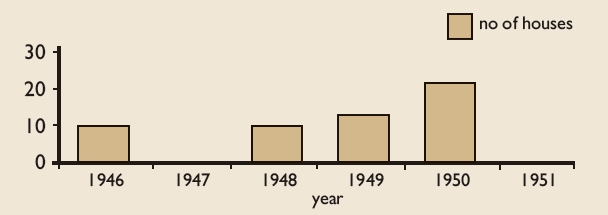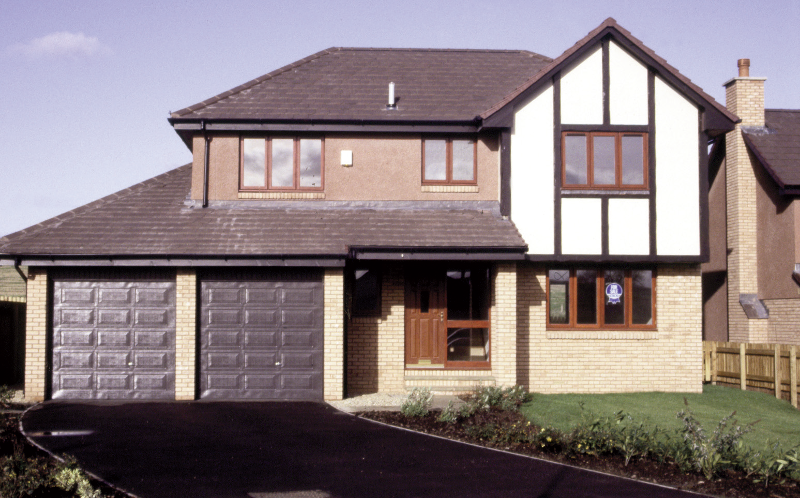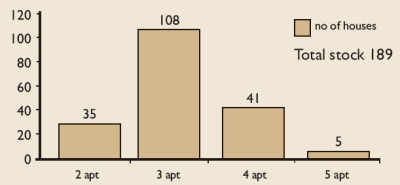One of the first priorities for the new Attlee government to address in 1945 was the provision of immediate housing and the burgh was given an allocation of ten prefabricated houses in September of that year. Land within the burgh was restricted but the town council had earmarked 5.38 acres west of Browns Place and Hardie Terrace in 1943.
In March 1946, the construction of 46 new houses was agreed with the erection of the ten prefabs at Braeview beginning in March that year. This provided some immediate relief to the housing shortage and the pressure on families living in overcrowded conditions in the post-war baby boom. The economic position acted as a brake on the development plans and the construction of the permanent homes was phased until 1951. In March 1951, permission was given for a further 20 new houses at the rear of Drylaw Gardens.
Town council completions, 1946-51

Total: 56 houses – Note: no houses were completed in 1947
Interestingly, in a report on East Lothian development in 1953, it was suggested that the post- war demand for local authority houses had now largely been met, adding:
The county council’s list contains no applicants who cannot be satisfactorily housed in other communities.
Its author continued:
East Linton presents very few planning problems. Unlike the other burghs, the provision of houses is not likely to be a major issue. Most, if not all of these, are likely to be built by private developers and sufficient sites in and around the burgh are available to leave them a fairly wide choice.
But the problem of meeting housing need had not been resolved. Indeed, the housing waiting list in the burgh was making it even more difficult for those in need of housing from the wider parish to solve their accommodation problems, a particular issue for retiring farm workers leaving tied houses. Consequently, eight houses were erected by the county council at Orchardfield in 1950/51, to add to their existing stock of 30 houses built in 1928. By 1967, this problem was again addressed with the construction of a further 20 homes at Orchardfield by the county council. In the wider parish, housing on the farms was at best primitive; as the workforce requirements changed over the period, farm cottages became available for people other than farm workers (see Economy – Agriculture).
Standards of living, Markle Mains c1959
We – a couple and our five year old – lived in a cottage in a row. There was a living room, bathroom, scullery and a big bedroom – very big. We had electricity, and an open fire with a back boiler. We had no carpets – just lino. The water supply was private – and not very good.
Jenny Gray

Mill Wynd, East Linton looking north, 1967
Even farmhouses were unsophisticated, as this anonymous recollection of one on moving-in day in 1944 describes:
Most farmhouses are large but this house was small. It faced north and south, and its only architectural feature was a turret on the north side. This apparently dated it circa 1730. The outside was harling over unevenly sized stones and rubble cemented together.
The main entrance was on the centre of the south side of the house with another door to the side. This door entered into a scullery, which had a slate floor and a sink, the only furnishing. A wooden partition separated it from the dairy/larder which had wooden shelves and a red brick floor. It faced west and so was very hot in summer.
A door from the scullery led into the kitchen which was large, had a flagged floor, a low ceiling which had hooks inserted for hanging hams. A large black range was the only equipment, only one cupboard at the side of the range, which housed the hot water boiler and there was a small room off the kitchen. From the kitchen another door led into a passage which led into the hall. There were two rooms, the one on the left was rather small, had dark wallpaper and chocolate brown paintwork. The room on the right was quite large but there the paintwork was grass green and the wallpaper equally dark!
A stone staircase within the turret led to the bedrooms of which there were three, two of them were quite large but the third was small due to part of it being used to make a bathroom. Up a wooden stair were the two large attics which were lit by roof lights.
Every room had a fireplace, low ceilings, small windows and no electricity!
So far as future housing need within the burgh was concerned, the East Lothian County Council Planning Report of 1953 anticipated that 24 houses would be required by 1971. Based on a projected increase in population of 60, the report added that it was unlikely that the local authority would need to build any of these. (There is an interesting comment that ‘East Linton is not a place that is suitable to receive the planned decentralisation of population on any large scale’ which presumably related to the Glasgow overspill policy of the time.)
It also identified 20 substandard houses of which 13 were already condemned. Many of these were said to be cottages, which could be effectively reconstructed on their present site. In 1962, the burgh acquired more land for housing at Walker Terrace (ten houses), and agreed to redevelop Mill Wynd with four split-level houses. Tenders were agreed between 1968 and 1970 with the latter two projects awarded to W.H. Laing, the local contractor.
Burgh of East Linton: population projections to 1966

Source: County of East Lothian Survey Report 1953
The estimates for population growth at that time proved to be slightly ambitious with the burgh population for 1981 being only 1,162 and a reduction of 24 in the ten-year census figures between 1961 and 1971.
By the mid 1970s, new owner-occupied housing was being developed at The Dean. Further development followed with the release of market garden land at Kingsburgh to Freddie Clark, a builder who had already been encouraged to provide small new housing development in the county, with the remit to keep within the character of the community. Additional small developments were constructed at The Glebe, Muirfield Court in Mill Wynd, and the former prefab site at Braeview.

East Linton Housing Development Areas, 1945–2000
National government pressure on local authorities to release even more land for housing need in the private sector led to the proposed zoning of land for housing development at Drylawhill and the later purchase of land to the north west of the burgh boundary by Cala Homes. This developer brought designs that were more ubiquitous in appearance to its other housing sites and altered the traditional and irregular line of buildings, thus changing the visual appearance of the built environment. On the other hand, Cala Homes was responding to market forces. The first houses at Dunpender Road perhaps reflected the new market expectations and the increased number of two-car families. Even where garages were provided, some were not available for car access with the introduction and acquisition of larger vehicles or the use of the garage for storage of the other possessions of a 21st century family. The later phases of the development of this site were sold on by Cala Homes to suppliers of alternative house styles and less expensive houses, including some planned as ‘starter homes’, and with more properties per hectare.

In 1984,the local plan identified that 46% of the existing houses were built prior to 1919, 16% during the period 1919-51 and 36% since 1960. 81% were within the category of bungalow/cottage/villa, 8% terrace and 9% flatted accommodation. It was also reported that in 1980, ten district council houses had been sold under the Tenant’s Rights Act and 70% were three-apartment size. No two-apartment houses had been lost from stock at that time. By March 1994, the ‘Houses by type’ on the housing revenue account were as follows:
Council houses by type, March 1994

Source: Housing Plan 1995-96, Vol. 3. Total stock 189
The following figures show the reduction in council-owned stock arising from the right-to-buy legislation.
| East Lothian District Council Stock Changes 1975-94 | ||||||
|---|---|---|---|---|---|---|
| Stock at 15/5/75 | Additional | Removed | Total | Stock at 31/3/94 | Sold | % sold |
| 240 | 21 | 10 | 251 | 189 | 61 | 24.5 |
Source: Housing Plan 1995-2000
After 1994, the council housing figures were no longer collected by settlement but by the decentralised administrative housing area (and the East Lothian Council total). This makes comparison difficult and reflects a gap in management information systems. Also, the winding up of the government housing agency, Scottish Homes, resulted in the transfer of the public sector housing tenancies at Stories Park to the East Lothian Housing Association.
The provision of housing for those with special needs had been left to housing associations specialising in this form of accommodation; East Linton did not benefit from sheltered housing provided by the local authority in the period under review. The Abbeyfield Housing Association formed an East Linton group in 1974. This led to the acquisition of the former schoolhouse for conversion to accommodation for older people. The inadequacy of an adapted building with an increasing frail elderly population soon became clear. This resulted in a need for further modifications as housing standards deemed appropriate to meet the needs of older people changed.
Similarly, Ark Housing, an Edinburgh-based housing association, developed a group care home for adults with a learning disability in property that had been used as a police station from 1953, (still with a cell). East Linton was to be at the forefront of assisting the transition of people moving from long-stay hospital wards into community living. Before its demise in 1996, Lothian Regional Council agreed that the grounds of Prestonkirk Home, the former poor house, should be used to provide special needs housing for older people. Special provision was to be made in the design to care for the requirements of tenants with memory impairment. Castle Rock Housing Association undertook the first phase of special need housing, and the second phase of adapting the main building commenced in September 2001.
So far as the calculation of the estimated ‘sheltered housing need’ is concerned (as opposed to the provision), East Linton appeared in planning documents for housing for older people for a period of at least 25 years. The planning targets were based on the population over 65 in accordance with National Guidelines, criteria that changed as the concept of sheltered housing evolved. In the last housing plan for the period April 1995 to March 2000, the figures used for planning purposes were as follows:
| Sheltered Housing | Pop 65+ | Need 46/1000 | Shortfall |
|---|---|---|---|
| 1991 pop. | 304 | 14 | 14 |
| Medium Dependency | Need 80/1000 | ||
| 1991 pop | 304 | 24 | 24 |
On the basis of these figures, East Linton was the only area in East Lothian that lacked provision in both categories, a position it had maintained since this method of planning was introduced after 1975. The housing development in the grounds of Prestonkirk Home was intended to meet the shortfall.
Utilities
Piped water had been introduced in the 1900s, using the main supply pipe installed in 1884 by North Berwick Council.
A major initiative by the burgh council took place in 1971 when Provost Rennie opened an advanced Pasveer sewage system, the first of its kind to be built in Scotland; the contractor was the local firm, W.H. Laing & Son. While some houses have installed solar heating systems in their roof space, no other renewable energy systems are available in numbers except that there is a continuing use of timber for firewood where houses still have open fires or wood burning stoves.
Electricity supplies were only installed in some houses in Walker Terrace as recently as 1948.
East Linton Gas Works at Lauder Place finally closed in March 1958 as the national grid system became available.
Television reception in parts of the parish can be variable and some aerials are tuned to Grampian rather than Scottish television as a result. Satellite dishes are now common but no cable TV is available and land-based digital services are still in their infancy.
Telephone numbers in 1945 still reflected the original number system with a change in the 1980s to a six number basis using 860 as the first three digits. By 2000, the number of resident phone numbers led to the addition of the 861 prefix with an abundance of mobile phones from different telecommunication companies.
Horses were still on duty in the old burgh in 1945. They were employed to deliver logs from the local timber yard, deliver vegetables or to pull the dustcart, but the last horse in use was for Myra Brown’s dairy. The responsibility for cleansing services was transferred to the county council in 1962. Bottle and paper bank facilities are now available in an attempt to recycle waste material.
One additional ‘service’ which has been carried out in a dedicated way over the period is the maintenance of Jessie the clock by four generations of the Govan family who wind it up weekly and change the hour twice per year on behalf of East Lothian Council. The same family were also responsible for the renovations to the fountain mechanism in the Square and for its subsequent maintenance.

Fountain, East Linton, looking north, c1970
Shops & Services
In 1945, East Linton was still a market town in its activity, with a range of shops and services. The auction market was used every fortnight for the sale of livestock, and the old mill at Preston churned out meal for customers far and wide. Along the High Street, there were eight grocers, three butchers, three bakers, a fishmonger, two dairies, two shoe shops, a cobbler and a saddler.
Most of these have now gone along with the three blacksmiths, three coal merchants and the three market gardens. Those that now survive are either offering an essential service such as. newspapers, a chemist, post office, lottery access and seven-day shopping or have a reputation which attracts customers from further away, such as quality butcher or grocer services. A number of attempts have been made to run a coffee shop in recent years and a ‘fresh bake’ – as opposed to a bakery – shop is a recent addition from 1996. Tradesmen continue to be valued for their traditional skills in masonry, joinery, painting and decorating, plumbing, gas and electrical installations, but there is also a new input with computer design, accountancy and architects (of which two firms operate from offices). The Royal Bank of Scotland still operates a local branch on a part-time basis but with no provision of a cash machine. However, a cash-back facility is available to customers at the Co-op.
Another interesting trend is the development of e-commerce and the Internet. One example is the manufacture of fortified wines based on fruits such as blackberries as a home industry for local trade and also for sale through the Internet. Sir George Buchan-Hepburn had tried to promote a cottage industry in growing apples to supplement income in the early 1800s. While he did not succeed in getting this idea put into practice, there is now the potential for the world to be a market place for the right product.
In the same vein, Internet shopping for food is available from some supermarkets, but this and the extent of the e-market in catalogue shopping is difficult to quantify. Accessibility and quality of the product is perhaps the key challenge and is reflected in the recent introduction of seven-day opening by the local Co-op supermarket. That does not mean that traditional skills are not needed but provision may have to be sought outwith the parish. Horses still need to be shod where they are kept for pleasure; welding and roof tiling are essential services but their providers can service a wider geographical area.
Mobile shopping services now also exist in the form of greengrocery and two fresh fish vans. The former service is provided by a resident in East Linton who, until 2000, also operated with a shop in Prestonpans. Coal supplies are still available but there is now no resident coal merchant.
The public library service developed as a local authority function after 1948. The first library in East Linton was opened in 1966 but residents outwith East Linton (but within the parish) could also have access to a mobile library service. The potential of the library as an advice and information service was still at an early stage of development compared with some other centres in East Lothian and elsewhere. The former Prestonkirk Home was available for renovation in 1996 and had been identified as a potential new library base. In 2000, it remains vacant; the contractors are to begin refurbishment of this Victorian building in 2001. Part of the building is to be made into flats, and the rest into East Linton’s new library and a small day centre for older people.